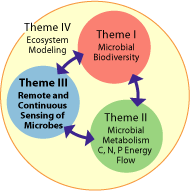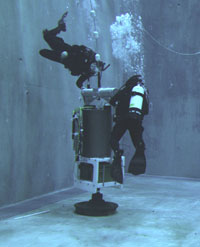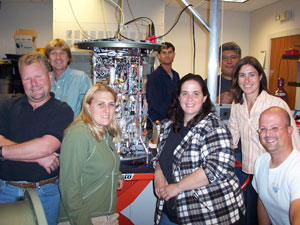- C-MORE Home
- Member Area
- What is Microbial Oceanography?
- What is C-MORE?
- C-MORE Hale
- Research
- Theme I: Microbial Biodiversity
- Theme II: Metabolism and C, N, P & Energy Flow
- Theme III: Remote and Continuous Sensing; Links to Climate Variablilty
- Theme IV: Ecosystem Modeling, Simulation, and Prediction
- Research Cruises
- Data
- Education & Outreach
- People
- Publications
- Microscopy Images
- Professional Development Training Program
- Summer Course
- C-MORE Highlights
- Meeting Facilities
- Contact Us
 Research Themes
Research Themes
Theme III: Remote and continuous
sensing of microbial processes and links to climate variability

Christopher Scholin (Theme III Leader)
Monterey Bay Aquarium Research Institute (MBARI)
The overall goal of Theme III is to develop and apply new autonomous sensor systems, as well as utilize existing systems, so that C-MORE investigators can remotely and in a sustained fashion:
- Assess bulk biological, chemical and physical properties of study sites;
- Conduct whole community metabolic rate measurements;
- Utilize molecular biological techniques to detect specific genes and gene products;
- Couple observations and models to generate hypotheses; and,
- Develop the capability for testing hypotheses in situ.
|
Divers inspect the 2G ESP fitted for in-water applications in a test tank at MBARI before the instrument is deployed in Monterey Bay. The instrument as shown here can be moored at depths from near surface to 50m. A deep-water version of the ESP (the D-ESP) is being developed. The prototype D-ESP is rated to 1000m and will be deployed using an remotely operated vehicle. |
The team and the challenge
Theme III investigators bring a wide range of expertise and complementary perspectives for developing and applying sensor systems (Table 1). Some sensors are highly developed, commercially available, and in use now on a range of platforms (satellites, aircraft, moorings, ships, AUVs, gliders, profiling floats, drifters). Other sensors represent maturing technologies that are appropriate for some but not all platforms. Finally, there are emergent technologies that are under active development at a variety of institutions but are not yet proven for extended deployments on ships or appropriate for in situ use in the open ocean.
The sensors available to C-MORE researchers provide disparate types of information. Some give a measure of bulk properties of the ocean, while others are directed at detecting specific organisms and even genes. Each sensor is designed to work at a characteristic spatial and temporal scale, typically independent from other sensors that are deployed concurrently. Some instruments will be used to provide continuous contextual measurements over long periods of time (years) that serve a wide spectrum of investigations (C-MORE and beyond). Other sensor systems may be deployed for process studies of short duration (weeks-months) and must be tuned to target particular processes, organisms and genes to address specific questions generated by C-MORE investigators. Field stuidies will not only utilize available sensors in a coherent way, but will also serve to refine the design and applications of new sensors that Theme III investigators will generate.
Table 1. Theme III participants
C-MORE |
Web links |
Institutional Affliation |
Role in Theme III |
R. Letelier |
Applications of bio-optical sensors |
||
Z. Kolber |
MBARI Biophysical Oceanographic Sensor Array (BiOSA) |
Development and application of bio-optical/bio-physical sensors |
|
C. Taylor |
Development of in situ samplers and incubation chambers for assessing metabolic rates |
||
C. Scholin |
MBARI Environmental Sample Processor (ESP): Sites for technical audience and general audience |
Development and application of genomic sensors |
|
J. Zehr |
C-MORE Theme II lead; applications of genomic data for developing new in situ sensors; N-cycling |
||
E. DeLong |
C-MORE Deputy Director; Development and application of genome proxy arrays derived from environmental samples |
||
M. Church |
Time series investigations involving genetic controls of biogeochemical cycles |
||
G. Steward |
Development and application of DNA probe arrays to study microbial community composition and activity |
||
M. Gardner |
Education and outreach; ESI |
||
*G. Matsumoto |
Education and Research: Testing Hypotheses (EARTH); MBARI summer internship coordinator |
||
M. Rappé |
Development and application of automated methods to study microbial community composition and activity |
||
P. Kemp |
Development of nucleic acid hybridization based microbial biosensors |
||
* Dr. Matsumoto is affiliated with C-MORE through his work with Dr. Scholin and the ESP at MBARI [ Top of Page ] | |||
Steps being taken towards Y1 implementation
The grand vision cast under Theme III speaks to a sustained ‘sensor presence’ at multiple study sites that are not easily accessed routinely (e.g., daily) in-person. The details of where instruments are placed (platform, depth, time) and the specifics of how they are applied will be derived from the multi-disciplinary query into the role that marine microorganisms play in mediating bigogeochemical cycles in the ocean. Against the backdrop is the quest to better understand how natural and human-mediated environmental change affects microbial communities and the processes they mediate.
It is clear that some sensors will be deployed on a variety of platforms and make measurements routinely and frequently. Others systems will be located at fewer sites on a limited number of platforms and must collect/process discrete samples, and still others will utilize “wet chemistry” analytical techniques. The latter are often slow and may only provide a limited number of measurements compared to other sensors that are highly distributed and providing nearly continuous chemical or biological measurements. Combing and visualizing data from those different types of instruments and coordinating their function in space and time will offer a powerful tool for generating and testing hypotheses. Modeling (Theme IV) will be key in this regard. Questions as to how all this equipment will actually be deployed and when must be considered from the outset and answered as soon as possible. Operational realities need to be brought to light now so that we can adequately plan for field campaigns that are several years away.
|
Members of the ESP team and collaborators. Gathered around the instrument are (L to R), Greg Doucette (NOAA/NOS, Charleston, SC), Chris Scholin (MBARI), Chris Preston (MBARI), Scott Jensen (MBARI), Tina Mikulski (NOAA/NOS, Charleston, SC), Roman Marin III (MBARI), Dianne Greenfield (MBARI), and Joe Jones (MBARI). |
Experiments that require or benefit from an event detection and response capability are anticipated. Triggering discrete sampling/analytical events and redirecting mobile platforms using portable computers and the internet are likely to be common features of integrated process studies that C-MORE investigators will undertake.
The long-term objective of Theme III is to move beyond traditional time series measurements and realize integrated sensor systems that make it possible for investigators to carry out interactive experiments and test hypotheses remotely, in situ. This will take some years to achieve, particularly for systems that must be built de novo. Thus, to be successful, we are galvanizing a diverse group of C-MORE researchers and engineers from the inception of the project to help prioritize expenditure of the limited research and engineering resources at our disposal.
[ Top of Page ]





